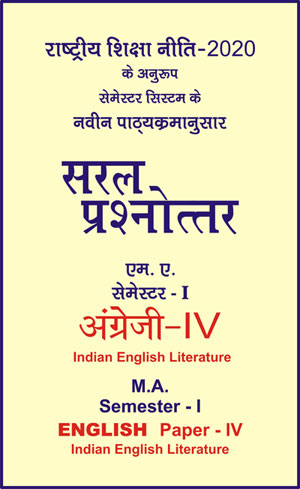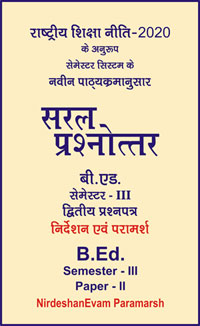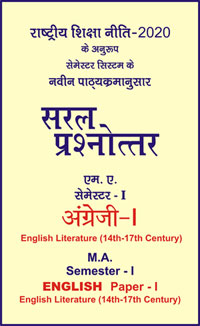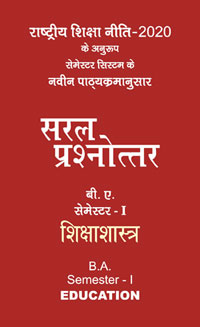|
बी ए - एम ए >> एम ए सेमेस्टर-1 - अंग्रेजी - चतुर्थ प्रश्नपत्र - इण्डियन इंगलिश लिटरेचर एम ए सेमेस्टर-1 - अंग्रेजी - चतुर्थ प्रश्नपत्र - इण्डियन इंगलिश लिटरेचरसरल प्रश्नोत्तर समूह
|
|
|||||||
एम ए सेमेस्टर-1 - अंग्रेजी - चतुर्थ प्रश्नपत्र - इण्डियन इंगलिश लिटरेचर
Question- Write the development of Indian English Poetry, since the 1980s.
Answer -
In the history of Indian English Poetry, M.K. Naik classifies the evolution of Indian English poetry from the beginning of the 19th century to the end of the 20th century into three distinct phases: The Romantic Dawn', The Modern its Noontidi' and 'Younger Accents: Modernism - 11' (Naik, 7-8). These phases, as explained by Naik are well known to literary historians, scholors and academics such a distinctions, as evident in his study, provides a panoramic view of the development of Indian English poetry based on the attitude of the poets belonging to different periods of Indian history. The Indian poets in the first phase adopted a romantic sensibility, quite similar to their British counterparts. They were primarily influenced by the Romantic Poetry of words worth, Coleridge, Shelley, Keats and Byron. These British poets provided suitable modi's for poets like Henry Derozio, Michael Modhusuden Dutt, Toru Dutt, Sarojini Naidu and Sri Aurobindo, to imitate and create poems bearing the mark of British imagination. While explaining the attitude of the early Indian English poets, who belonged to the 'Romantic Dawn' phase, Naik clearly elucidates the basic tendency of these poets : "Almost all the early Indian English poets considered so for had taken the British Romantic poets as their models; in spite of this, they had failed to produce genuine Romantic poetry, because, in a sense, they were not 'romantic' enough, i.e. they merely copied the external featured of Romantic Poetry, missing the core together". These poets as evident from the list mentioned above belonged to the pre-independence period. Among these poets, Toru Dutt and Sri Aurobindo made sincere attempts to write poems based on Indian myths and legends, which rendered a spirit of originality to their creative works, though they could not completely resist the imitative mode of writing poems. The second phase. The Modernist Noontide' indicates the point of view of the post-independince Indian English poets. The poets of this phase rejected the romantic model of writing poetry and developed a modernist outlook. Following the themes and styles of modern British poets the poets of the 1950s and the 1960s, acquired a typical modern perspective of representing reality. Naik observes this phenomenon by stating the change in the source of inspiration for the poets of the post independence era: "But it is true that poetic taste had changed. The Indian poet is no longer prone to deriving his light from Shelley and Tennyson. His masters now are T.S. Eliot and W.H. Audin" (Naik, 52). This derivative modernism influenced the creative spirit of the Indian English poets as they imbibed all the major traits of British Modernism. Aspects like, 'alienation syndrome', urbanity', 'obessive sense of failure, 'exile, pessimism intertextuality and a tendency to experiment with the form and the content of poetry, figure distinctly in the poetry of this phase (Naik,53). Nissim Ezekiel, Dom Moraes, Adil Jussawala, A.K. Ramanujan. P. Lal, Gieve Patel, A.K. Mehrotra and Pritish Nandy are the representative poets of the Modernist phase. In fact, the first significant collection of modern Indian English poetry, Modern Indo-Anglian Poetry (1959), edited by P.Lal and K.R.Rao, addresses the poets of the modernist phase as the 'new poets:' According to Lal, the poets of this phase must write poems that, works must deal in concrete terms with concrete experience", and such works must also, "be free from propaganda".
Another poet whose contribution is unique in terms of his thematic representation of homosexual love is Hoshang Merchant. He is probable the first Indian poet to celebrate homosexuality by articulating his disive for another male partner, "Merchant's verse," as Naik opines, "is unique in the frank and uninhibited celebration of homosexual love... The poet records of varying moods and vicissitudes of homosexual love, its tragedies and its triumphs."
In the introduction of Indian Poetry in English (1993) Paranjape classifies the post-1980 poets as representative of Postmodernism'. Postmodernism seems to promise a variety of new devices including parody, pastiche, collage, intertentuality and diterary cennibalism of variety degrees. New poetry on thologies published in the twenty first centuary are prominently reflective of the panoramic dimension of Indian English poetry. Sudeep Sen's edited anthology, The Harper Collins Book of English Poetry (2012) is an excellent instance of showcasing the immensity and diversity of Indian English poetry. This anthology is a comprehensive one, as it contains the illushative poems of eighty five significant poets of the late twentiesh and early twenty first centuaries. A cursary look at the names of the poet end their poem indicets the vastness and flenibility of Indian English poetry. A broad range of themes including diaspore, cosmopolitanism, urbanity, Love, sex, body homosexuality, northeast landscape and culture and dalit identity has have now permeated the conon of English poetry. This obuiously theatre and this remark altest to the fact that his plays are original pieas bearing the mark of the author's sinces engagement with the listing and politics of India. During his career as a dromatist, cumimbhoy produced twenty nine play which deal with a variety as themes, reflecting his desire to infuse the spirit of authenticity of representation in the canon of Indian English drama. Natesaon Sharada Iyer acknowledges the contribution of currimbhoy by describing his ability to represent the contemporary society through diverse persepectives. He chose to with dramas because he left that this was the art form which as usual themes from contemporary Indian Society and women them into plays of artistic encellence. Hence, currimbhoy rescued Indian English drama from the shackles of initation and poor quality productions. He breathed a new life into the canon, reforming its nature and identify. The dramatists of the 1960s and the 1970s were inspired by the efforts of currimbhoy to write plays in English a phenomenon which accelerated the growth of the canon. Pratap Sharma, Nissim Frekiel, Guru Charan Das and Girish Karnad, are the important playwrights of the 1966s and 1970s and this plays are remarkable instences of original persepectives on Indian history, myths, socio-cultural scenarios and political ambience, Girish Kannad rose To eminence in the 1970s with plays like Tughlog (1972) and Hayauadana (1975). These plays reflest karnad's experimental mindrest as he fuses myth, history, politics and human psychology to create a complex thematic structure GuruCharan Das is also a significant dramatist of this period and his play, Larins Sahib (1970) offers an encellast perspective on the colonial history of Punjab during the time when Henry Lawrence visited India.
Many playwrights of the contemporary generative are receiving the alteration of a global audience. Girish Karnad, Mahesh Dattani, Manjula Padmanabhan, Rana Bose, and Guruchran Das, have earned the appreciation of drama crities, and they have also won several awards from reputed international institutes and agencies. Indian English plays are now performed in different countries, which was previously a very save phenomenon. There aspects indicate a bright future ahead, hoping that the canon achieves a protean structure like the other two major genres. However the only big challenge that the canon is probably encountering at the present moment is the influence of cyber culture with new kindly edition of novels and poetry arriving in the market, how can drama, which is meant for both reading and performance, negotiate with this new mode of culture? As a performative art, will drama lose its power to influence people directly? there indeed are vital questions, which will decide the future of Indian English drama.
The whole book has been divided into two broad units: Contemporary Indian English poetry, and contemporary Indian English Drama. The first unit contains nine critical essays on contemporary Indian English poetry, focusing primarily on new emerging aspects in the canon. The essays in this unit are further classified into four different sections. In the first section. "Changing Canons : Some Reflections", the essay of Ajay Kumar discusses the approaches of modern Indian English poets mainly foursing on the empirical approach used by Arun Kolatkar, A.K. Ramanujan, and R. Parthasarathy, These modern poets kumar argees, have used the empirical approach to trace the roots of their culture. The second section, "Representation of the Nation and the Diaspora", presents four insightful critical pieces. Sajal Kumar Bhattacharya's essay, "My piecemeal shelters exploring the Diasporis Womans voice in selected poems of Meena Alexender", offers remarkable perspective on the poems of Meena Alexander by primarily focusing on the representation of the conditions of diasporic women. Bhattacharya believes that Alexander's poems brilliantly represent the voice of womens, attempting in the process to construct a womens aesthetics.
The second unit of this book, contemporary Indian English drama (1980-2012). Contains six essays, which have been further classified into three different sections based on the thematic aspects. The first section of this unit, "Changing canons : Some Reflections", Presents three insightful essays, Anita Singh's essay, "Re-drawing Boundaries of the canon: Indian English women Dramatists", provides a comprehensive survey of Indian English women Dramatists, who according to singh, have made attempts of redefine the canon of Indian English drama. Analyzing the contribution of the women dramatists of India, Singh identifies the important links between these dramatists, to examine the method of their dramatic composition.
|
|||||
- Question- Write about Post-Colonial Indian writings in English Literature?
- Question- What is Postmordanism in English Literature?
- Question- Write an essay Postmoderism's influence of Indian writing in High Ab Han English Literature?
- Question- What is Dalit Literature?
- Question- Write about Dalit's voice: A voice from the Margin?
- Question- Write the development of Indian English Poetry, since the 1980s.
- Question- What is experimental Theatre?
- Question- What is Indians in Indian "English Literature”?
- Question- Define the term 'Indian English Literature'?
- Question- What is contemporary poetry in English Literature?
- Question- What is India drama in English Literature?
- Question- What is experimental Poetry?
- Question- Write about the origin of structuralism and Post-structuralism.
- Question- Write the theory of Post-modernism.
- Question- What do understand by the post-colonialism?
- Question- Write the influence of Postmoderanism on English Literature?
- Question- Write about the Renaissance in India and other essays on Indian culture.
- Question- Write about Renaissance in India and the nature of India culture as explicated by Sri Aurobindo.
- Question- Who is Sri Aurobindo? Give an introduction of him.
- Question- What are the ideas on Indian culture of Aurobindo, given in his essay 'Indian culture and external influence'?
- Question- Write an introduction of Dr. Sarvepalli Radhakrishnan. with whole life.
- Question- What is Idealism?
- Question- Write an introduction of 'An Idealist View of Life' by Radhakrishnan.
- Question- How does an idealist view life?
- Question- Write an introduction of Nirad C. Chaudhari.
- Question- Write the background of the book 'A passage to England' by C. Chaudhari.
- Question- Write a summary of 'A Passage to England' with giving an introduction of book. and describe 'The English Scene'.
- Question- What is the purpose of Chaudhari to write 'A Passage to England?
- Question- Write a short note on the life and works of Mrs. Meenakshi Mukherjee.
- Question- What do you know about The Perishable Empire : Essays on Indian writing in English' by Meenakshi Mukherjee?
- Question- Critically appreciate the poem The Harp of India'.
- Question- Give a brief life sketch of Henry Derozio.
- Question- Write a short note on Young Bengal Movement.
- Question- Provide a brief background of the poem 'The Harp of India'.
- Question- What do you know about part 1 of the poem?
- Question- What do you know about part 2 of the poem?
- Question- What impact has the prevailing conditions of the times made on India in the poem 'The Harp of India'?
- Question- Expalin with reference to the context any two of the following passeges.
- Question- Write a critical appreciation of 'Love Poem for a Wife' by A. K. Ramanujan.
- Question- In which style 'Love poem for a wife' is written? Explain.
- Question- Expalin with reference to the context any two of the following passeges.
- Question- Who is R. Parthasarathy? Write about his life and career.
- Question- What is the summary of the poem 'Exile from Homecoming"?
- Question- Write a Critical appreciation of the poem 'Exile From Homecoming'.
- Question- What has happened to poetry and why?
- Question- Why does the speaker recommend newspapers?
- Question- What is the introduction of 'Exile From Homecoming'?
- Question- Expalin with reference to the context any two of the following passeges.
- Question- What is the introduction of the poem 'Palanquin-Bearer'?
- Question- What is the critical appreciation of "The Palanquin Bearers'?
- Question- Write life and works of Sarojini Naidu.
- Question- What is the message in Palanquin Bearers by Sarojini Naidu?
- Question- What is the mood, tone and setting of the palanquin Bearers?
- Question- What is the Summary of the poem The Palanquin Bearers'?
- Question- Expalin with reference to the context following passege.
- Question- Write life and works of Shiv K. Kumar.
- Question- Write a note on Shiv K. Kumar as a poet.
- Question- Write a critical appreciation of the poem, 'Pilgrimage'.
- Question- Expalin with reference to the context following passege.
- Question- What do you know about Dom Moraes?
- Question- What is the summary of the poem "Bells for William Wordsworth".
- Question- Expalin with reference to the context following passege.
- Question- What is the summary of the poem Tribute to Papa' by Mamta Kalia?
- Question- Mamta Kalia's poem Tribut to Papa' is quest for an identy. Write about it?
- Question- Expalin with reference to the context following passege.
- Question- Explain how myth and symbolism are integral parts of Raja Rao's fictional act in Kanthapura.
- Question- What are the main features of Raja Rao's narrative technique in Kanthapura?
- Question- The three levels of action in Kanthapura-political, social and religious are all related to a unified concept of India. Discuss the structure of the novel in the light of the statement.
- Question- Provide a summary of the novel 'Kanthapura'.
- Question- What are the important themes one can find in Kanthapura?
- Question- Place Raja Rao in the context of the evolution of the Indian writing in English.
- Question- What do you know about the historical and political background of Kanthapura?
- Question- How deep and wide is the impact of Gandhi's personality and his thought on the theme of Kanthapura?
- Question- What do you know about Kanthapura and its people?
- Question- What is the significance of the Skeffington Coffee Estate in the overall account of the village in Kanthapura?
- Question- What are those qualities that go into the making of Moorthy, the central figure in Kanthapura?
- Question- What do you think of the women characters in Kanthapura? What is their role in the action of the novel?
- Question- How successful is Moorthy in leading his followers in the Satyagraha movement of the village?
- Question- Write a short essay on 'Considerations of Caste' in Kanthapura.
- Question- How successful is Achakka, the narrator in her attempt to tell the story of her village in the context of the Satyagraha movement?
- Question- Comment on some of the male character - other than Moorthy in Kanthapura.
- Question- What are some important themes in the novel 'The Guide'?
- Question- Provide a detailed character sketch of Raju (The Guide).
- Question- Can The Guide' be called a picaresque novel?
- Question- Comment on the narrative technique in "The Guide'.
- Question- Unravel the various aspects of Rosie's character in the light of the novel.
- Question- Sum up the literary elements found in the novel.
- Question- How is the concept of universality explored in the novel?
- Question- Write a short note on R.K. Narayan.
- Question- What do you know about Raju from 'The Guide'?
- Question- Give a brief character sketch of Rosie.
- Question- What importance does the town 'Malgudi' carry in most of the novel of R.K. Narayan?
- Question- Give a brief character sketch of Marco.
- Question- Write a brief character sketch of Velan.
- Question- How is title of the novel 'The Guide' appropriate?
- Question- Critically analyze the novel The Guide.'
- Question- Is Raju a transformed man by the end of the novel?
- Question- Is Velan a mere fool or a major accessory to Raju's transformation?
- Question- What roles do dharma and Karma play in the text?
- Question- What are the some important metaphors we come across after reading in the novel?
- Question- Write about the whole life of Shashi Deshpande with works.
- Question- Shashi Deshpande's craft as a novelist a study with special reference to 'That long Silence'
- Question- What is theme of the novel 'That Long Silence'?
- Question- Describe Jaya's Quest for self in "That Long Silence' by Shashi Deshpande.
- Question- What do you mean by the title of the novel 'That Long Silence'?
- Question- What is the introduction of Shashi Deshpande?
- Question- What is 'That Long Silence' about?
- Question- What is the relationship between Jaya and Mohan in the "That Long Silence'?
- Question- Who always reminds Jaya That husband is like sheltering tree?
- Question- Who is Kamat in the novel 'That Long Silence'?
- Question- What is the Indroduction of Firdaus Kanga's 'Trying to Grow'?
- Question- Analysis of Trying to Grow' by Firdaus Kanga.
- Question- Describe of Parsi Community in "Trying to Grow' by Firdaus Kanga?
- Question- Who is Firdaus Kanga?
- Question- What is the major achievement of 'Firdaus Kanga'?
- Question- Write about the sixth Happiness, BFI/BBC Film in 'Trying to Grow' by Firdaus Kanga.
- Question- Write life and works of Arundhati Roy.
- Question- How has Arundhati Roy projected the illicit or incestuous relations in 'The God of Small Things'?
- Question- Evaluate The God of Small Things' as a tale of confrontation as its theme.
- Question- Give a brief character sketch of Estha and Rahel.
- Question- Why did the relationship of Ammu and Velutha came to an abrup end?
- Question- Relate the atrocities faced by Ammu all her life and her insignificant end?
- Question- Describe the Roy's use of symbols and images in her novel.
- Question- Write the life and works of Ilavenil Meena Kandasamy.
- Question- What is the introduction of the novel 'When I Hit You?
- Question- Describe the portrayal of domestic violence in 'When I Hit You?
- Question- Write about The Feminism in 'When I Hit You?
- Question- What is the summary of the story "Two Lady Rams"?
- Question- Write a note on Indian-ness in "Two Lady Rams' by Mulk Raj Anand.
- Question- What is the significance of the Title 'Two Lady Rams'?
- Question- Who was the first wife of Lalla Jhinda Ram?
- Question- Who is Lalla Jhinda Ram?
- Question- Analyse the story "Two Lady Rams'.
- Question- Write about the life of Salman Rushdie.
- Question- Write about the carrer of Salman Rushdie.
- Question- Write the summary of the story "Free Radio" by Salman Rushdie.
- Question- Who was the narrator in the short story "The Free Radio'?
- Question- Justify the title of the story "The Free Radio'.
- Question- Who is Ramani and what is the role of Ramani in this story "The Free Radio'?
- Question- What is the introduction of the story 'The Free Radio'?
- Question- Why is the narrator so much concerned for Ramani?
- Question- What does the Free Radio Symbolize in the story free radio'?
- Question- Write about the sexism in the story 'The Free Radio'?
- Question- Write a summary of the story 'The Intrusion'.
- Question- Analyse the story "The Intrusion' as a quest for identity
- Question- Write about the human predicament and emotional suffocation in Shashi Deshpande's short story "The Intrusion'.
- Question- Write the justification of the title "The Intrusion.'
- Question- What does the wife want in the story "The Intrusion'?
- Question- Who is the intruder in the story 'The Intrusion'?
- Question- What is the summary of the story 'Diamond Dust' by Anita Desai?
- Question- Write about the themes of 'Diamond Dust' by Anita Desai.
- Question- Who is Mr. Das in the Story 'Diamond Dust'?
- Question- What is the role of Mrs Sheila Das in 'Diamond Dust?
- Question- Who is Diamond in the story 'Diamond Dust'?
- Question- Attempt a critical appreciation of Vijay Tendulkar's play, Silence! The Court is in Session.
- Question- Attempt an essay on Tendulkar's delineation of women in his play, silence! The court is in Session.
- Question- Discuss Tendulkar's humour satire and irony in 'Silence! The Court is in Session.'
- Question- Justify the title of Vijay Tendulkar's play, Silence! The Court is in Session.
- Question- Write a short note on the role of Sukhatme in the mock-trial in Tendulkar's play, Silence! The Court is in Session.
- Question- Wite the character sketch's of Mr. Kashikar.
- Question- Give a short account of Miss Benare as a teacher.
- Question- What verdict does Kashikar give in Benare's case?
- Question- Write a short note on Balu Rokde.
- Question- Bring out the significance of prof. Damle in Silence! The Court is in Session.
- Question- How does Tendulkar's play, Silence ! reveal society's partiality towards woman?
- Question- Life and work of Grish Karnad.
- Question- What is the introduction of 'The Fire and the Rain'?
- Question- Discuss the central themes of Girish Karnad's play, 'The Fire and the Rains'.
- Question- Write a character sketch of Yavakri.
- Question- Write a critical note on Paravasu-Vishakha relationship.
- Question- Write a character sketch Raibhya.
- Question- Comment on the significance of the role of the Actor Manager in "The Fire and the Rain'.
- Question- Wha is the theme of 'The Fire and The Rain'?
- Question- Who is Raibhya in "The Fire and The Rain'?
- Question- Who is Andhaka in the 'The Fire and The Rain'?
- Question- Who is Arvasu?
- Question- Write a note on the life and works of Manjula Padmanabhan.
- Question- Write the summary of 'Harvest' by Manjula Padamanabhan.
- Question- Write a note on Themes and Techniques in Manjula Padmanabhan's plays.
- Question- Who is the man character of the play 'Harvest'?
- Question- Who is Jaya in the story 'Harvest'?
- Question- How does Ginni control Om and his family?
- Question- Who is Ginni in the play 'Harvest'?
- Question- Discuss the theme of exploitation in the play 'Harvest'.

 i
i 










